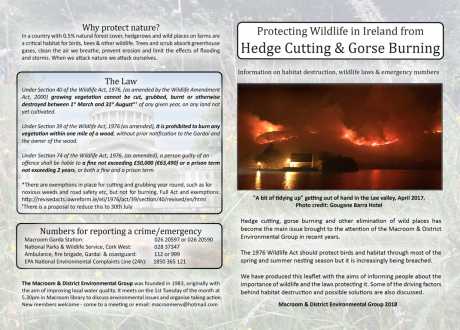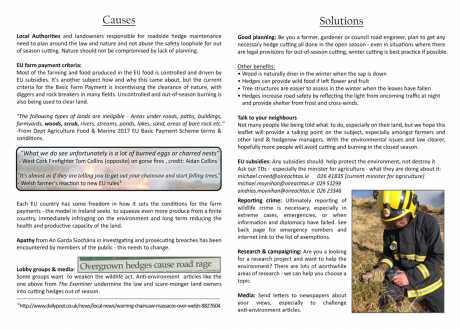MDEG Publishes Wildlife Protection Leaflet
 cork |
environment |
press release
cork |
environment |
press release  Thursday April 19, 2018 15:20
Thursday April 19, 2018 15:20 by MDEG - Macroom and District Environmental Group
by MDEG - Macroom and District Environmental Group
Publication Marks Anniversary of Gougane Barra Inferno
The Macroom and District Environmental Group have published a new leaflet aiming to protect wildlife in Ireland.
The leaflet titled Protecting Wildlife in Ireland from Hedge Cutting and Gorse Burning marks the anniversary of the catastrophic gorse fires that burned hundreds of acres of wildlife habitat at Gougane Barra in April 2017. [1]
Macroom and District Environmental Group PRO Ted Cooke said: "The benefits and functions of hedgerows were considered of such importance that at our groups first AGM in April 1985 their conservation were listed in the group's mission statement. Their centrality as wildlife corridors across Ireland's landscape provide the critical network for genetic exchange and dispersal for mosses, lichens, fungi, amphibians, wood-mice, shrews, hedgehogs, stoats, bats and the larger mammals, mayflower, primrose and woodbine, the roosting, resting, hunting, nesting and breeding of our resident and migratory wild birds and thousands of species of insects. We also know that where ten or more consecutive meters of hedgerow is lost the local colonies of bats are disrupted."
The leaflet says that the 1976 Wildlife Act was introduced to protect nesting birds stating: "...growing vegetation cannot be cut, grubbed, burnt or otherwise destroyed between 1st March and 31st August of any given year on any land not yet cultivated." [2]
Mr Cooke continued: "A healthy, working, stock-proof hedge comprises four storeys: the ground-field storey, the shrub layer, the under canopy, and the canopy, which gives it the structural diversity of natural woodland. Farmers well know the benefit to their cattle of browsing the wild plants of the field boundary, especially ivy to calving and lactating livestock. Simply observe cattle 'under the wet pelt of a November hill the colour of fox' as they gather for shade, shelter and sisterhood under the hedges. Farmers and growers have free access to nature's own pest control corps - many of our wild birds feed of crop pests. Additionally a dense road or field boundary filters and traps particulate matter down to 1.5 micron in size."
He added: "The bulk of County Cork's hedgerow network - our largest man-made monument in the county - date from the 1667 Enclosure Cattle Act. These are permanent features that impart stability to the landscape and hold the very soils and their fertility together, more especially in view of climate disruption, with its increasing extreme weather events that wash out precious soil nutrients, particularly metals and minerals. Consequently the phenomenon of soil creep invariably follows where field boundaries have been grubbed out. Additionally their service of intercepting leachate run-off and flood event mitigation protects our water courses, homes, farms and towns."
"That Cork County Council - despite its biodiversity action plan - along with the NPWS (National Parks and Wildlife Service), EPA and other statutory agencies charged with the guardianship of our hedgerows, continue to relegate to wholly untrained Hedge-cutting Contractors the so called management of our county's single most important ecological feature is ethically depraved."
The leaflet mentions the importance of allowing hedges to flower and fruit as a food source. Mr Cooke added: "Our bee-keepers well know the value of Hawthorn and Blackberry blossom to their bees, more-so their protein-rich pollen. As Mrs Harding of Cork said in 1990:
'How the town dweller longs for countryside blooming
And dreams of green meadows and by-ways o'ergrown
And summer airs laden with the perfume of flowers
Where songbirds sing loud and our honeybees roam'
"This re-emerging potential honey industry in the city and countryside is predicated on wisely managed hedgerows - Macroom Environmental Group's advice to both town dwellers and farmers is honour the provisions of the Wildlife Act and EU Birds Directive and plan to avoid disrupting nature from March 1st to August 31st."
The leaflet singles out EU farm payment criteria as a driver for land clearing.
Mr Cooke said: "The Macroom and District Environmental Group will continue to campaign and highlight the glaring conflict between the criteria of the EU Basic Farm Payment scheme and the provisions of the EU Birds Directive - that protects all birds in the wild state during each stage of their life-cycle.
"This conflict arises because the Basic Farm Payment scheme rewards land owners per acre of cultivated land, and while GLAS (formerly REPS) purports to reward retention of woodland and scrub features, the fiscal attraction of the Basic Farm Payment scheme drives the annexation of wild space. Additionally the government Harvest 2020 strategy that aims to increase milk production by 50% - and now the so called Food Wise 2025 Vision - is profoundly at odds with the absolute requirement that every human being supports natures recovery. Progressive overstocking of the national herd together with the so called 'wildfires' - themselves driven by the EU Basic Farm Payment criteria - now pose the greatest threat to Irish Wildlife at this time. Even the short term economic precarity of this strategy has been shown up by the current fodder crisis."
Reflecting on the one year anniversary of the burning of Gougane Barra Mr Cooke said: "Group members acknowledge Guagane Barra Hotel for providing us with the picture included in the leaflet of the incineration of our iconic Gougane Barra - the county's best loved site of pilgrimage and veneration".
"We reject the use of the term 'wildfires' - like Global Warming, the torching of our uplands is man-made. Atmospheric carbon dioxide concentration is currently running at 403ppm (parts per million) - unbridled burning of our uplands, themselves major carbon sinks will very likely and finally break the climatic thermostat."
Mr Cooke concluded: "We humbly but loudly call for an awakening - within individuals and local communities as the primary stakeholders - and within our statutory agencies, to observe and implement our existing wildlife protection legislation. It is as clear as day that the criteria, the indicators and the verifiers underlying the policies both within the Food Harvest 2025 Vision and the EU farm payment scheme are inherently and dangerously unsustainable, and it is high time for policies that embody the concept of sustainability as defined at the 1992 Rio Earth Summit - to which the Irish State is a signatory - which says that sustainable development is measured by the health or otherwise of biodiversity at the local, regional, and global level." [3]
Copies of Protecting Wildlife in Ireland from Hedge Cutting and Gorse Burning are available free of charge in Macroom library and can also be viewed online, downloaded, printed. [4]
ENDS
For more information contact:
Ted Cooke: 0868789891
Links
[1] Article on Gougane Fire: https://www.irishexaminer.com/breakingnews/ireland/fire....html
[2] The 1976 Wildlife Act: http://revisedacts.lawreform.ie/eli/1976/act/39/section.../html
[3] The Rio Earth Summit Declaration: https://www.un.org/documents/ga/conf151/aconf15126-1ann...1.htm
[4] Protecting Wildlife in Ireland from Hedge Cutting and Gorse Burning leaflet: http://www.indymedia.ie/article/106572

